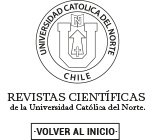La ratificación del Protocolo Facultativo CEDAW
implicancias y desafíos del procedimiento de comunicaciones individuales para el Estado de Chile
DOI:
https://doi.org/10.22199/issn.0718-9753-4700Palabras clave:
discriminación contra la mujer, Comité para la Eliminación de la Discriminación contra la Mujer, Sistema Universal de Derechos Humanos, derechos humanos en ChileResumen
La reciente ratificación del Estado de Chile al Protocolo Facultativo de la Convención sobre la eliminación de todas las formas de discriminación contra la mujer (PFCEDAW) invita a reflexionar sobre el modo en que Chile se ha relacionado con procedimientos de comunicaciones individuales del Sistema Universal de Derechos Humanos. El presente artículo describe y analiza estos procedimientos, enfocándose especialmente en el rol del Comité para la eliminación de la discriminación contra la mujer. Además, analiza críticamente las razones que dilataron la ratificación del PFCEDAW, y articula los desafíos principales que supone este tratado internacional para la institucionalidad chilena de derechos humanos.
Citas
Abril Stoffels, R. (2015). El Comité de la CEDAW ante las comunicaciones individuales: Requisitos de admisión y medidas provisionales. Revista electrónica de estudios internacionales, (30), 1-23 https://doi.org/10.17103/reei.30.10
Abril Stoffels, R. (2019). The role of the CEDAW Committee in the implementation of public policies on gender issues: analysis through a study of the protection of girls’ rights in Spain. The International Journal of Human Rights, 23(8), 1317-1336. https://doi.org/10.1080/13642987.2019.1603144
Byrnes, A. (2000). An effective complaints procedure in the context of International Human Rights law. En A. Bayefsky (Ed.) The UN human rights treaty system in the 21st century (pp. 139-162). Brill. https://doi.org/10.1163/9789004502758_014
Callejon, C., Kemileva, K. y Kirchmeier, F. (2019). Treaty bodies’ individual communication procedures: providing reddress and reparation to victims of Human Rights. The Geneva Academy of International Humanitarian Law and Human Rights. https://bit.ly/2M9Wu81
Campbell, M. (2016). Women's rights and the convention on the elimination of all forms of discrimination against women: Unlocking the potential of the optional protocol. Nordic Journal of Human Rights, 34(4), 247-271. https://doi.org/10.1080/18918131.2016.1248002
Campbell, M. (2018). Women, poverty, equality: the role of CEDAW. Bloomsbury.
Case Concerning Ahmadou Sadio Diallo (Republic of Guinea v. Democratic Republic of Congo) (International Court of Justice 30 de noviembre de 2010). https://bit.ly/3sRLUDm
Case of the S. S. Wimbledon (Permanent Court of International Justice 17 de agosto de 1923). https://bit.ly/3999DHt
Chamusco, B. (2017). "If he beats you, it means he loves you": Domestic violence and women's rights in Russia. International Immersion Program Papers, 44. https://bit.ly/3c2O7pR
Chinkin, C. (2018). Sources. En D. Moeckli, S. Shah y S. Sivakumaran (Eds.), International Human Rights Law (3a ed., pp. 64-85). Oxford University.
Claudia Andrea Marchant Reyes, Erika Cecilia Hennings Cepeda, Felipe Esteban Aguilera Rodríguez, Gloria Raquel Elgueta Pinto, Juan Francisco Ilarraza Vergara, Juan René Maureira Moreno, Karen Glavic Maurer, Leopoldo Montenegro Montenegro, Magdalena Mercedes Navarrete Faraldo, Miguel Alberto Ávila Pino, Paulina Andrea Bravo Castillo, Viera Stein Melnick, María José Pérez Bravo, Libio Eduardo Pérez Zúñiga y Daniela Cornejo Cornejo v. Chile, Comunicación individual N° 2627/2015 (Comité de Derechos Humanos 7 de noviembre de 2017). https://bit.ly/39XLD9y
Coddou Mc Manus, A. (2019). La institucionalidad de Derechos Humanos en Chile: el Instituto Nacional de Derechos Humanos, la Subsecretaría de Derechos Humanos, y la política exterior chilena. En F. Vargas Rivas (Ed.), Informe Anual sobre Derechos Humanos en Chile 2019 (pp. 533-590). Universidad Diego Portales. https://bit.ly/48ayIgI
Comité de Derechos Humanos (2008). Observación General N° 33, sobre las obligaciones de los Estados parte con arreglo al Protocolo Facultativo del Pacto Internacional de Derechos Civiles y Políticos. (CCPR/C/GC/33/CRP.3). Organización de la Naciones Unidas. https://bit.ly/2KF6G8f
Comité de Derechos Humanos (2021). Reglamento del Comité de Derechos Humanos. (CCPR/C/3/Rev.12). Organización de la Naciones Unidas. https://bit.ly/3QE4Un1
Comité para la eliminación de la discriminación contra la mujer (2018). Observaciones finales sobre el séptimo informe periódico de Chile. (CEDAW/C/CHL/CO/7). Organización de la Naciones Unidas. https://bit.ly/2Y61220
Comité para la eliminación de la discriminación contra la mujer (2011). Anexo Dictamen del Comité para la Eliminación de la Discriminación contra la Mujer a tenor del artículo 7, párrafo 3 del Protocolo Facultativo de la Convención sobre la eliminación de todas las formas de discriminación contra la mujer (50º período de sesiones) respecto de la Comunicación Nº 22/2009. Organización de la Naciones Unidas. https://bit.ly/3qNpP74
Comité para la eliminación de la discriminación contra la mujer (17 de noviembre de 2020). Working Methods of the Committee on the Elimination of Discrimination Against Women and its Working Group on individual communications received under the Optional Protocol to the CEDAW Convention. Naciones Unidas, Oficina del Alto Comisionado para los Derechos Humanos. https://bit.ly/3NdZzRg
Commission on the Status of Women (1997). Additional views of Governments, intergovernmental organizations and non-governmental organizations on an optional protocol to the Convention Report of the Secretary-General. En Economic and Social Council, Convention on the elimination of all forms of discrimination against women, including the elaboration of a draft optional protocol to the convention (E/CN.6/1997/5). Organización de la Naciones Unidas. https://bit.ly/2LV3GVO
Connors, J. (2012). Optional Protocol. En M. Freeman, C. Chinkin y B. Rudolf (Eds.), The UN convention on the elimination of all forms of discrimination against women: A commentary (pp. 607-639). Oxford University.
Connors, J. (2018). “Protection”. En D. Moeckli, S. Shah y S. Sivakumaran (Eds.), International Human Rights Law (3a ed., pp. 369-410). Oxford University.
Constitución española, Boletín Oficial del Estado, Madrid, España, 29 de diciembre de 1978. https://bit.ly/3YtVafY
Convención sobre la eliminación de todas las formas de discriminación contra la mujer. Adoptada y abierta a la firma y ratificación, o adhesión, por la Asamblea General en su resolución 34/180, de 18 de diciembre de 1979. Organización de las Naciones Unidas, 03 de septiembre de 1981. https://bit.ly/47W42Qi
Decreto con Fuerza de Ley N° 3. Fija el texto refundido, coordinado y sistematizado de la Ley Orgánica del Ministerio de Justicia y Derechos Humanos. Diario Oficial de la República de Chile, Santiago, Chile, 31 de Enero de 2017. https://bcn.cl/2qvrp
Decreto N° 747. Promulga el protocolo facultativo del pacto internacional de derechos civiles y políticos. Diario Oficial de la República de Chile, Santiago, Chile, 20 de agosto de 1992. https://bcn.cl/2nbtj
Decreto N° 778. Promulga el pacto internacional de derechos civiles y políticos adoptado por la Asamblea General de la Organización de las Naciones Unidas por Resolución N° 2.200, el 16 de diciembre de 1966 y suscrito por chile en esa misma fecha. Diario Oficial de la República de Chile, Santiago, Chile, 29 de abril de 1989. https://bcn.cl/2ho0j
Decreto N° 789. Promulga la convención sobre la eliminación de todas las formas de discriminación contra la mujer, adoptada por la Asamblea General de las Naciones Unidas el 18 de diciembre de 1979. Diario Oficial de la República de Chile, Santiago, Chile, 09 de diciembre de 1989. https://bcn.cl/2f7fz
Decreto N° 808. Promulga la convención contra la tortura y otros tratos o penas crueles, inhumanos o degradantes, adoptada por la asamblea general de la organización de las naciones unidas mediante resolución 39/46, de fecha 10 de diciembre de 1984. Diario Oficial de la República de Chile, Santiago, Chile, 26 de noviembre de 1988. https://bcn.cl/2j4t4
Dulitzky, A. E. (2015). An Inter-American Constitutional Court? The Invention of the Conventionality Control by the Inter-American Court of Human Rights”. Texas International Law Journal, 50(1), 45-93. https://bit.ly/44wlJUR
Estela Deolinda Yrusta y Alejandra del Valle Yrusta v. Argentina, Comunicación individual N° 1/2013 (Comité contra la Desaparición Forzada 12 de abril de 2016). https://bit.ly/3qHt7Je
Estela Deolinda Yrusta y Alejandra del Valle Yrusta v. Argentina, Comunicación individual N° 778/2016 (Comité contra la Tortura 23 de noviembre de 2018). https://bit.ly/361w53i
Farha, L. (2009). Women claiming economic, social and cultural rights -The CEDAW Potential”. En M. Langford (Ed.), Social Rights Jurisprudence: Emerging Trends in International and Comparative Law (pp. 553-568). Cambridge University. https://doi.org/khst
Forst, R. (2010). “The Justification of Human Rights and the Basic Right to Justification: A Reflexive Approach”. Ethics, 120(4), 711-740. https://doi.org/10.1086/653434
Forst, R. (2011). The Right to Justification: Elements of a Constructivist Theory of Justice (J. Flynn, Trad.), Columbia University. https://bit.ly/3iCbKXq
Fox Principi, K. (2017a). Implementation of decisions under treaty body complaints procedures – Do states comply? How do they do it? [Informe]. UN Office of the High Commissioner for Human Rights. https://bit.ly/3TiRe2C
Fox Principi, K. (2017b). Internal Mechanisms to Implement U.N Human Rights Decisions, notably of the U.N. Human Rights Committee / How can these mechanisms assist States to fulfil their good faith obligations?. Human rights law journal, 37(7-12), 237-251.
Freeman, M. y Chinkin, C. (2012). Introduction. En M. Freeman, C. Chinkin y B. Rudolf (Eds.), The UN convention on the elimination of all forms of discrimination against women: A commentary (pp. 1-33). Oxford University.
García Ramírez, S. (2015). The relationship between Inter-American Jurisdiction and States (National Systems): some pertinent questions. Notre Dame Journal of International & Comparative Law, 5(1), 115-152. https://bit.ly/3XAsnHD
Global Alliance of National Human Rights Institutions (2016). National Human Rights Institutions and United Nations Treaty Bodies [GANHRI Background Paper]. https://bit.ly/3D2LVuw
Grupo de Trabajo sobre el Examen Periódico Universal. (02 de abril de 2004). Chile [Informe]. ONU. https://bit.ly/484MphX
Guzman, A. T. y Meyer, T. L. (2010). International Soft Law. Journal of Legal Analysis, 2(1), 171-225. https://doi.org/10.1093/jla/2.1.171
Hanski, R. y Scheinin, M. (Comp.). (2007). Leading Cases of the Human Rights Committee. Abo Akademi University.
Harrington, J. (2003). Punting Terrorists, Assassins and Other Undesirables: Canada, the Human Rights Committee and Requests for Interim Measures of Protection. McGill Law Journal, 48, 55-87. https://bit.ly/46y05Br
Historia del Decreto Supremo Nº 46. Aprueba protocolo facultativo de la convención sobre la eliminación de todas las formas de discriminación contra la mujer. Biblioteca del Congreso Nacional, Valparaíso, Chile, 24 de junio de 2021. https://bit.ly/3CQCq1J
Hodson, L. (2014). Women´s Rights and the Periphery: CEDAW´s Optional Protocol. European Journal of International Law, 25(2), 561-578. https://doi.org/10.1093/ejil/chu027
Holtmaat, R. (2015). The CEDAW: a holistic approach to women’s equality and freedom. En A. Hellum y H. Sinding Aasen (Eds.), Women's Human Rights: CEDAW in International, Regional and National Law (pp. 95-124). Cambridge University.
Huneeus, A. (2011). Courts Resisting Courts: Lessons from the Inter-American Court’s Struggle to Enforce Human Rights. Cornell international law journal, 44(3), 493-533. https://bit.ly/3NYGwLt
Johnstone, I. (2011). The power of deliberation. Oxford University.
Joseph, S., Mitchell, K., Gyorki, L. y Benninger-Budel, C. (2014). Cómo hacer valorar los derechos de las víctimas de la tortura: un manual sobre los procedimientos de presentación de denuncias individuales ante los órganos de tratados de las Naciones Unidas (2a ed.). OMCT Red SoS-Tortura. https://bit.ly/395FU2b
Klabbers, J. (2015). An Introduction to International Organizations Law. Cambridge University.
Lacey, N. (2004). Feminist Legal Theory and the Rights of Women. En K. Knop (Ed.), Gender and Human Rights (pp. 13-57). Oxford University. https://doi.org/khvk
L.C v. Perú, Comunicación individual N° 22/2009 (Comité para la Eliminación de todas las formas de Discriminación contra la Mujer 25 de noviembre de 2011). https://bit.ly/3qNpP74
Limon, M. (2018). Reform of the UM Human Rights Petitions System: An assessment of the UN human rights communications procedures and proposals for a single integrated system. Universal Rights Group. https://bit.ly/3qK6jIG
Merry, S. E. (2003). Rights Talk and the Experience of Law: Implementing Women's Human Rights to Protection from Violence. Human rights quarterly, 25(2), 343-381. https://doi.org/10.1353/hrq.2003.0020
Ministerio de Justicia y Derechos Humanos (2019). Situación de la Comisión Interamericana de Derechos Humanos: una mirada global [Informe Interno].
Monitoring the implementation of the Nairobi forward-looking strategies for the advancement of women: other issues. Elaboration of a draft optional protocol to the Convention on the Elimination of All Forms of Discrimination against Women [Informe del Secretario General]. Organización de las Naciones Unidas. Consejo Económico y Social. Comisión de la Condición jurídica y social de la Mujer, 10 de enero de 1996. E/CN.6/1996/10. https://documents.un.org/prod/ods.nsf/home.xsp
Murdoch, J. (2010). Unfulfilled Expectations: The Optional Protocol to the Convention on the Elimination of Discrimination against Women. European human rights law review, (1), 26-46.
O.G. v. Federación de Rusia, Comunicación individual N° 91/2015 (Comité para la Eliminación de todas las formas de Discriminación contra la Mujer 6 de noviembre de 2017). https://bit.ly/39TEneN
Oette, L. (2018). The UN Human Rights Treaty Bodies: Impact and Future. En G. Oberleitner (Ed.), International Human Rights Institutions, Tribunals, and Courts (pp. 95-115). Springer. https://doi.org/10.1007/978-981-10-5206-4_5
Opuz v Turkey, N° 33401/02 (Corte Europea de Derechos Humanos 9 de junio 2009). https://bit.ly/3bY7twe
Organización de la Naciones Unidas (2014). Informe nacional presentado con arreglo al párrafo 5 del anexo de la resolución 16/21 del Consejo de Derechos Humanos. Chile. En Consejo de Derechos Humanos. Grupo de Trabajo sobre el Examen Periódico Universal. 18º período de sesiones, 27 de enero a 7 de febrero de 2014 (A/HRC/WG.6/18/CHL/1). https://bit.ly/47fLPhk
Organización de las Naciones Unidas (1945). Estatuto de la Corte Internacional de Justicia. En Carta de las Naciones Unidas. https://bit.ly/3sfP7Bz
Organización de las Naciones Unidas (2013). Procedimientos para presentar denuncias individuales en virtud de tratados de derechos humanos de las Naciones Unidas (Folleto informativo N° 7/Rev.2). Oficina del Alto Comisionado. https://bit.ly/39QbxvO
Organización de las Naciones Unidas, Oficina de Derechos Humanos. (2022). OHCHR Juris Database. https://juris.ohchr.org/
Phillips, E, y Pugh, D. (2015). How to get a PhD: A Handbook for Students and their Supervisors. McGraw Hill.
Pimentel v. Brasil, Comunicación individual N° 22/2009 (Comité para la Eliminación de todas las formas de Discriminación contra la Mujer 27 de septiembre de 2011). https://bit.ly/3QuHvo3
Protocolo Facultativo de la Convención sobre la eliminación de todas las formas de discriminación contra la mujer. Organización de las Naciones Unidas, Asamblea General, 06 de octubre de 1999. https://bit.ly/44IrQ9b
Ravetllat Ballesté, I., y Contreras Rojas, C. (2019). El Protocolo facultativo de la Convención sobre los Derechos del Niño relativo a un procedimiento de comunicaciones. Estudio a la luz de su aplicabilidad. Estudios constitucionales, 17(2), 225-264. https://doi.org/khxj
Reilly, Niamh (2009). Women´s Human Rights: Seeking Gender Justice in a Globalizing Age. Polity.
Reparations for Injuries Suffered in the Service of the United Nations (Advisory Opinion) (International Court of Justice 11 de abril de 1949). https://bit.ly/3sMwUXr
Resolución 48/134. Instituciones nacionales de promoción y protección de los derechos humanos. Asamblea General de las Naciones Unidas, 4 de marzo de 1994. A/RES/48/134. https://documents.un.org/prod/ods.nsf/home.xsp i
Resolución 68/268. Fortalecimiento y mejora del funcionamiento eficaz del sistema de órganos creados en virtud de tratados de derechos humanos, Asamblea General de las Naciones Unidas, 24 de abril de 2014. A/RES/68/268. https://documents.un.org/prod/ods.nsf/home.xsp
Reyna Trujillo Reyes and Pedro Arguello Morales v. México, Comunicación individual N° 75/2014 (Comité para la Eliminación de todas las formas de Discriminación contra la Mujer 21 de julio de 2017). https://bit.ly/2Y8VEuM
Romano, C. P. R. (2013). The Rule of Prior Exhaustion of Domestic Remedies: Theory and Practice in International Human Rights Procedures. En N. Boschiero, T. Scovazzi, C. Pitea y C. Ragni (Eds.), International Courts and the Development of International Law: Essays in Honour of Tullio Treves (pp. 561-572). Springer, pp. 561-572. https://doi.org/10.1007/978-90-6704-894-1_41
R v Ewanchuk, Nº 26493 (Corte Suprema de Canadá 25 de febrero de 1999). https://bit.ly/3o7fbq9
Salama, I. (2011). Remarks by Ibrahim Salama. Proceedings of the annual meeting - American Society of International Law, 105, 515-520. https://doi.org/khxk
Scheinin, M. (2005). Reservations to the International Covenant on Civil and Political Rights and Its Optional Protocols – Reflections on State Practice [Manuscrito no publicado]. University of Galway.
Sonia Yaker v. Francia, Comunicación individual N° 2747/2016 (Comité de Derechos Humanos 17 de julio de 2018). https://bit.ly/2LXF4vt
STS 1263/2018 (Tribunal Supremo, Sala de lo Contencioso-Administrativo, España 17 de julio de 2018). https://bit.ly/3sOiLZL
Suttle, O. (2016). Law as Deliberative Discourse: The Politics of International Legal Argument – Social Theory with Historical Illustrations. Journal of International Law and International Relations, 12(1), 151-203. https://bit.ly/44y8sLG
Ulfstein, G. (2012). Individual complaints. En H. Keller y G. Ulfstein (Eds.), UN Human Rights Treaty Bodies: Law and Legitimacy (Studies on Human Rights Conventions, pp. 73-115). Cambridge University. https://doi.org/10.1017/CBO9781139047593.004
Van Alebeek, R. y Nollkaemper, A. (2012). The legal status of decisions by human rights treaty bodies in national law. En H. Keller y G. Ulfstein (Eds.), UN Human Rights Treaty Bodies: Law and Legitimacy (Studies on Human Rights Conventions, pp. 356-413). Cambridge University. https://doi.org/10.1017/CBO9781139047593.009
Vishaka v State of Rajasthan, Nº 666-70 (Corte Suprema de India 13 de agosto de 1997). https://bit.ly/3iFzny8
Zwingel, S. (2016). Translating International Women´s Rights, Gender and Politics. Palgrave Macmillan. https://doi.org/10.1057/978-1-137-31501-4
Publicado
Cómo citar
Número
Sección
Derechos de autor 2023 Alberto Raúl Coddou Mc Manus

Esta obra está bajo una licencia internacional Creative Commons Atribución 4.0.
Aquellos autores/as que tengan publicaciones con esta revista, aceptan los términos siguientes:
- Los autores/as conservarán sus derechos de autor y garantizarán a la revista el derecho de primera publicación de su obra, el cuál estará simultáneamente sujeto a la Licencia de reconocimiento de Creative Commons que permite a terceros compartir la obra siempre que se indique su autor y su primera publicación esta revista.
- Los autores/as podrán adoptar otros acuerdos de licencia no exclusiva de distribución de la versión de la obra publicada (p. ej.: depositarla en un archivo telemático institucional o publicarla en un volumen monográfico) siempre que se indique la publicación inicial en esta revista.
- Se permite y recomienda a los autores/as difundir su obra a través de Internet (p. ej.: en archivos telemáticos institucionales o en su página web) antes y durante el proceso de envío, lo cual puede producir intercambios interesantes y aumentar las citas de la obra publicada. (Véase El efecto del acceso abierto)





_(1).png)











